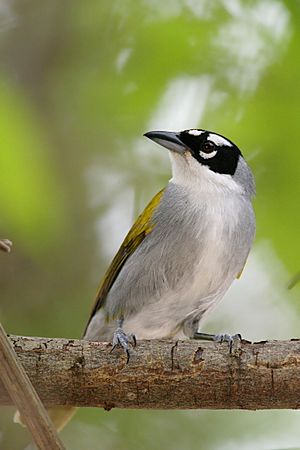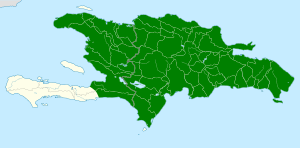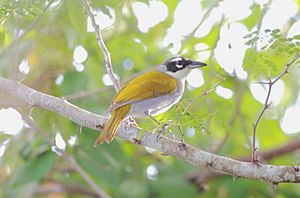Black-crowned palm-tanager facts for kids
Quick facts for kids Black-crowned palm-tanager |
|
|---|---|
 |
|
| Conservation status | |
| Scientific classification | |
| Genus: |
Phaenicophilus
|
| Species: |
palmarum
|
 |
|
| Range in green | |
| Synonyms | |
|
Turdus palmarum Linnaeus, 1766 |
|
The black-crowned palm-tanager (Phaenicophilus palmarum) is a cool bird found only on the island of Hispaniola. This island is shared by two countries: Haiti and the Dominican Republic. It's part of a special bird family called Phaenicophilidae, known as the Hispaniolan palm-tanagers.
Contents
About the Black-Crowned Palm-Tanager
How it Got Its Name
Back in 1760, a French scientist named Mathurin Jacques Brisson described this bird. Later, in 1766, the famous Swedish scientist Carl Linnaeus gave it its first scientific name, Turdus palmarum. The word palmarum means "of palm trees" in Latin, which makes sense because these birds are often found near palm trees!
Today, the black-crowned palm-tanager is placed in the genus Phaenicophilus. This genus was created by an English scientist named Hugh Edwin Strickland in 1851.
Family Ties
The black-crowned palm-tanager shares its genus with another bird, the grey-crowned palm-tanager. Sometimes, these two birds even mix and have babies together! For a long time, scientists thought these birds belonged to the "true" tanager family (Thraupidae). But in 2017, they were moved to their own special family, Phaenicophilidae. This bird is also monotypic, which means it doesn't have any different subspecies.
What Does It Look Like?
The black-crowned palm-tanager is about 17 to 18 centimeters (6.7 to 7.1 inches) long. It weighs around 24 to 32 grams (0.85 to 1.1 ounces). Boys and girls of this bird look very similar.
It has a strong, pointed beak. The top part of its beak is black, and the bottom part is blue-gray with a black tip. Its head is mostly black, but it has some cool white spots. There's a white patch above its beak, a bigger white patch above and behind its reddish-brown eye, and a thin white line under its eye.
The back of its neck is gray, and the rest of its upper body and tail are a bright yellowish-olive color. Its throat and the middle of its chest are white. The sides of its chest, belly, and the feathers under its tail are gray. Young birds have a dusky gray head instead of black, and their throat might look a bit yellowish.
Where Does It Live?
You can find the black-crowned palm-tanager all over the main part of the Dominican Republic, including on Saona Island. It also lives in Haiti, except for one area called the Tiburon Peninsula.
This bird is super adaptable! It lives in almost every kind of place on Hispaniola. You can find it in dry forests, humid forests, and even in open or dense areas. It also likes to hang out in gardens and parks, both in the countryside and in cities. It lives from sea level up to about 2,500 meters (8,200 feet) high, but it's most common below 2,000 meters (6,600 feet).
How Does It Behave?
Staying Put
The black-crowned palm-tanager doesn't migrate. It stays in the same area all year long.
What It Eats
These birds usually look for food in pairs or with their family groups. They search for food at all levels of the forest, from the ground to the treetops. Sometimes, they even join groups of different bird species looking for food together. Their diet is mostly insects (about two-thirds) and fruit (about one-third). They also enjoy a small amount of nectar.
Making a Family
The breeding season for the black-crowned palm-tanager is from April to June. They build a deep, cup-shaped nest in a tree or bush. Often, they build their nests close to where people live. A mother bird usually lays two or three eggs. The eggs hatch in about 10 days, and the baby birds are ready to leave the nest after another 10 days.
What Does It Sound Like?
The song of the black-crowned palm-tanager can sound a bit different depending on where the bird lives. Generally, it's described as "jumbled squeaky notes that grow louder, then get quieter and slow down to short 'chit' notes." Some birds might also include rough or buzzing sounds in their songs. Their calls include a "nasal, buzzy 'pe-u'," a higher, sharper "tseep," and a low "chep."
Is It Safe?
The IUCN (International Union for Conservation of Nature) has looked at the black-crowned palm-tanager and decided it is a species of "Least Concern." This means it's not currently in danger of disappearing. It lives in a very large area, and even though we don't know the exact number of birds, scientists believe its population is stable. No immediate threats have been found. It's considered common throughout its home range, lives in many protected areas, and has done a great job adapting to places changed by humans.
See also
 In Spanish: Phaenicophilus palmarum para niños
In Spanish: Phaenicophilus palmarum para niños



